Standing Rib Roast
hands-on time 10 minutes
roast 1 hour 45 minutes at 350°F
stand 15 minutes
- 1 4- to 6-lb. beef rib roast
- Kosher salt and freshly ground black pepper
- 2 to 3 cloves garlic, slivered
- 1 recipe Peppercorn-Horseradish Sauce (optional)
- Roasted potatoes and onions (optional) (chart)
1. Preheat oven to 350°F. Sprinkle meat with salt and pepper. Cut shallow slits all over meat and insert garlic slivers into slits. Place meat, fat side up, in a 15½×10½-inch roasting pan. Insert an oven-going meat thermometer into center of roast. The thermometer should not touch bone.
2. Roast, uncovered, 1¾ to 2¼ hours or until meat thermometer registers 135°F for medium rare. Cover roast with foil; let stand 15 minutes. (For medium, roast 2¼ to 2¾ hours or until meat thermometer registers 150°F.) Slice meat.
3. If desired, serve meat with Peppercorn-Horseradish Sauce and roasted potatoes and onions.
Makes 8 servings (7 oz. beef each).
each serving 541 cal., 40 g fat (16 g sat. fat), 169 mg chol., 211 mg sodium, 0 g carb., 0 g fiber, 0 g sugars, 41 g pro.

standing rib roast
BEEF RIB ROASTS include attached rib bones—which contribute flavor and act as a natural rack for the meat to roast on. To make carving easier, you can ask the butcher to cut the rack from the roast. Save the rack and use kitchen string to tie the roast to the ribs. After roasting, just untie bones and slice.
peppercorn-horseradish sauce
hands-on time 5 minutes
chill 1 hour
- 1 8-oz. carton sour cream
- 3 Tbsp. prepared horseradish
- 1 Tbsp. chopped fresh chives
- 2 tsp. white wine vinegar
- 1 tsp. coarsely ground black peppercorns
1. In a bowl stir together all ingredients. Cover and chill at least 1 hour before serving.
Makes 1½ cups (2 Tbsp. each).
each serving 40 cal., 4 g fat (2 g sat. fat), 11 mg chol., 22 mg sodium, 1 g carb., 0 g fiber, 1 g sugars, 1 g pro.
boneless ribeye roast
To roast a 3- to 4-lb. boneless ribeye roast instead, prepare as directed, except place roast on a rack in roasting pan. Roast 1½ to 1¾ hours or until 135°F for medium rare. (For medium, roast 1¾ to 2 hours or until 150°F.)
Oven-Roasted Beef Tenderloin
hands-on time 15 minutes
roast 35 minutes at 425°F
stand 15 minutes
- 1 Tbsp. olive oil
- 1 3-lb. beef tenderloin roast, trimmed
- 1½ tsp. kosher salt
- 1 tsp. black pepper
- 1 recipe Bordelaise Sauce and/or Peppercorn-Horseradish Sauce (opposite) (optional)
- Garnishes, such as fresh parsley and/or roasted garlic cloves (Roasted Garlic) (optional)
1. Preheat oven to 425°F. Brush oil over meat. Sprinkle salt and pepper over meat; rub in with your fingers.
2. Place roast on a rack set in a shallow roasting pan. Insert an oven-going meat thermometer into center of roast. Roast, uncovered, 35 to 40 minutes or until meat thermometer registers 135°F for medium rare. (For medium, roast 45 to 50 minutes or until meat thermometer registers 150°F.)
3. Transfer meat to a cutting board. Cover with foil; let stand 15 minutes. Slice meat across grain and arrange on a platter. If desired, serve with Bordelaise Sauce and/or Peppercorn-Horseradish Sauce. If desired, garnish with parsley and/or garlic.
Makes 12 servings (3 oz. beef each).
each serving 168 cal., 7 g fat (2 g sat. fat), 69 mg chol., 190 mg sodium, 0 g carb., 0 g fiber, 0 g sugars, 25 g pro.

oven-roasted beef tenderloin
TENDERLOIN—as the name implies—is the most tender cut of beef (and also one of the most expensive). Look for a roast that has been “peeled” (outside fat and connective tissue removed) for easy prep. It’s a very lean cut, so do not overcook it.
SECOND CHOICE
If beef tenderloin is out of your price range, try a 4-lb. beef top round roast. Roast it in a 350°F oven 1½ to 1¾ hours or until 135°F for medium rare. (For maximum tenderness, avoid roasting this cut past medium rare.)
Bordelaise Sauce
start to finish 40 minutes
- 1¼ cups reduced-sodium beef broth
- ¾ cup dry red wine
- 2 Tbsp. finely chopped shallot or onion
- 3 Tbsp. butter, softened
- 1 Tbsp. all-purpose flour
1. In a 2-qt. saucepan combine broth, wine, and shallot. Bring just to boiling; reduce heat. Simmer, uncovered, skimming the surface often with a spoon, 25 to 30 minutes or until reduced to 1 cup.
2. Using a fork, in a bowl stir together butter and flour. Whisk butter mixture into wine mixture, 1 tsp. at a time, whisking constantly (mixture will thicken). Cook and stir 1 minute more. Stir in ¼ tsp. salt.
Makes about 1 cup (2 Tbsp. each).
each serving 64 cal., 4 g fat (3 g sat. fat), 11 mg chol., 173 mg sodium, 2 g carb., 0 g fiber, 0 g sugars, 1 g pro.

make it a menu
oven-roasted beef tenderloin
CRISP SPINACH SALAD WITH BALSAMIC VINAIGRETTE
SOFT DINNER ROLLS
board-certified A party board keeps the whole meal—beef, shrimp, salad, and potatoes—in one spot for easy serving and easy cleanup. Double everything to serve more.
Peppered shoulder tenders
hands-on time 30 minutes
stand 20 minutes
roast 8 minutes at 400°F
- 2 to 3 beef shoulder petite tenders (about 1½ lb. total)
- 2 Tbsp. cracked black pepper
- 1½ tsp. kosher salt
- 2 Tbsp. vegetable oil
- 3 Tbsp. butter
- ¼ cup finely chopped shallots
- ⅓ cup Cognac or other brandy
- 1 cup heavy cream
1. Preheat oven to 400°F. Sprinkle meat with pepper and salt, pressing gently to adhere. Let stand at room temperature 20 minutes.
2. In a 12-inch oven-going skillet heat oil over medium-high heat. Add meat; cook about 8 minutes or until well browned on all sides. Transfer skillet to oven. Roast 8 to 10 minutes for medium rare (135°F). Remove meat from skillet and cover loosely with foil. Drain fat.
3. For pan sauce, in skillet melt butter over medium heat. Add shallots; cook 3 minutes, stirring occasionally. Remove skillet from heat. Carefully add Cognac, stirring to loosen any browned bits from skillet. Return to heat. Bring to boiling; reduce heat. Simmer, uncovered, until reduced by about half. Add cream. Return to boiling; reduce heat. Boil gently 3 to 5 minutes or until slightly thickened, stirring frequently. Slice meat and serve with pan sauce.
Makes 4 servings (5 oz. beef + about ⅓ cup sauce each).
each serving 643 cal., 48 g fat (24 g sat. fat), 188 mg chol., 605 mg sodium, 5 g carb., 1 g fiber, 3 g sugars, 37 g pro.
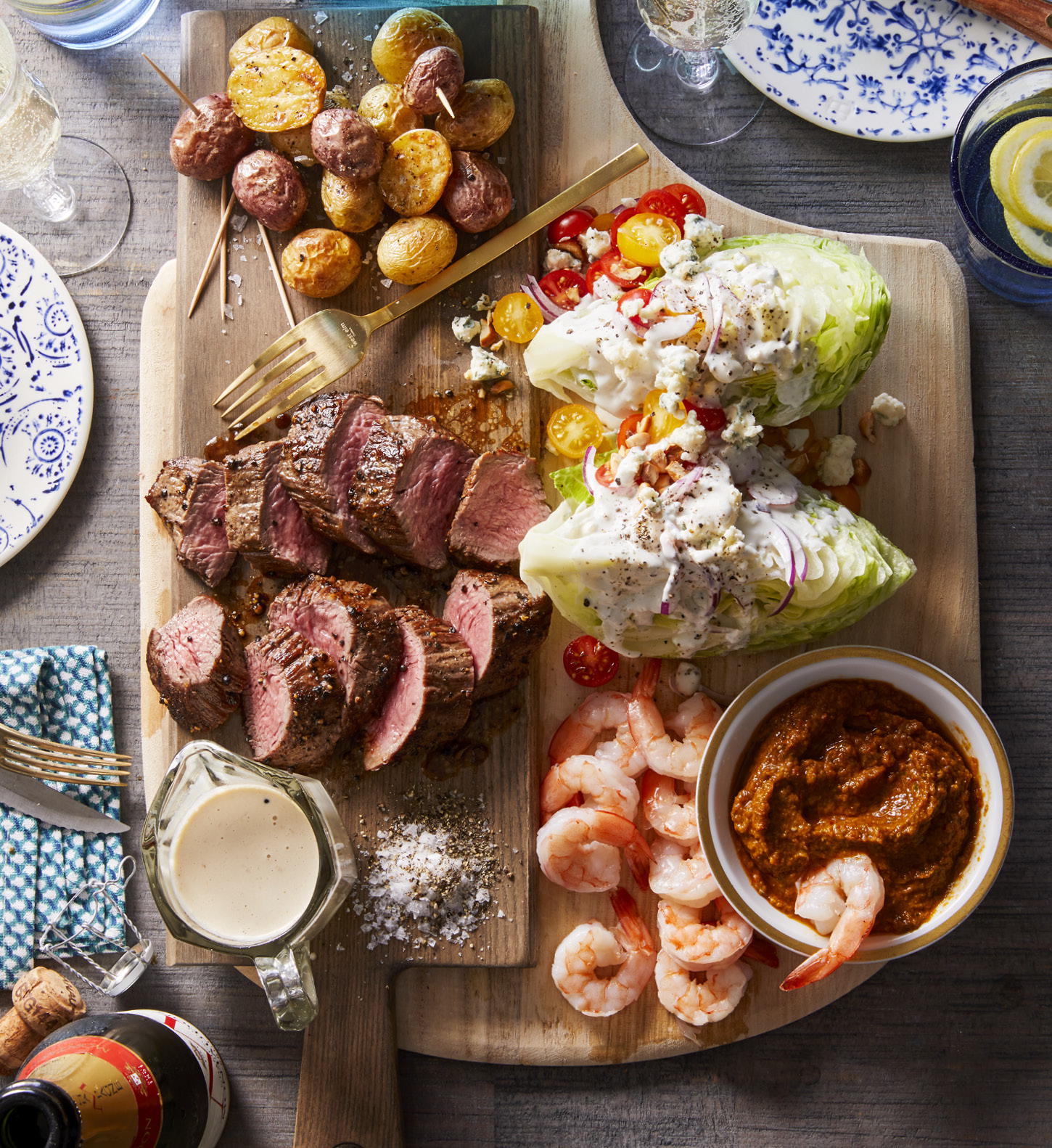
SHOULDER PETITE TENDERS are juicy and tender. If you can’t find, use a 1½ lb. center-cut tenderloin roast, trimmed. Roast about 35 minutes for medium rare (135°F).
Shrimp & sauce
Prepare Shrimp Cocktail (p. 394) or purchase chilled cooked shrimp at the meat and seafood counter of your supermarket. Then serve the shrimp with any of the sauces. Other options are Romesco Sauce and Chimichurri (see recipe). Or use purchased cocktail sauce, sweet-and-sour sauce, or dried tomato pesto.
iceberg wedge salad
Cut a head of iceberg lettuce into desired-size wedges, leaving core intact. Drizzle wedges with Blue Cheese Dressing (see recipe) and top with thinly sliced red onion, halved cherry tomatoes, crumbled blue cheese, and black pepper.
roasted potatoes
Toss tiny new potatoes with olive oil, salt, and black pepper; place in a single layer in a large baking pan. Roast in a 425°F oven about 30 minutes or until browned.
Texas-Style Beef Brisket
hands-on time 30 minutes
soak 1 hour
grill 4 hours
stand 20 minutes
- 4 cups mesquite or hickory wood chips
- ½ cup Dry Rub
- 1 5-lb. fresh beef brisket
- 1 recipe Brisket Barbecue Sauce
- 12 kaiser rolls or ciabatta buns, split
1. At least 1 hour before grilling, soak wood chips in enough water to cover; drain. Sprinkle Dry Rub over both sides of brisket; rub in with your fingers.
2. Prepare grill for indirect heat using a drip pan (info, Grilling). Fill drip pan with hot water. Sprinkle half of the wood chips over coals. Place brisket over drip pan. Grill, covered, 2½ hours; turn brisket. Grill, covered, 1½ to 2 hours more or until brisket is tender. Add coals and wood chips as needed to maintain temperature and smoke. (For a gas grill, add wood chips according to manufacturer’s directions. Fill a small disposable foil pan with hot water and place on grill rack over a lit burner. Place brisket on a rack in a roasting pan; place pan on grill rack over burner that is off. Grill as directed.) Remove brisket from grill. Wrap in heavy foil and let stand 20 minutes.
3. Meanwhile, prepare Brisket Barbecue Sauce. Thinly slice brisket across the grain. Serve brisket on rolls with sauce.
Makes 12 sandwiches.
To Make Ahead Prepare as directed. Refrigerate foil-wrapped brisket up to 2 days. Transfer sauce to a covered airtight container; refrigerate up to 1 week. To reheat, prepare grill for indirect heat. Grill foil-wrapped brisket over indirect medium heat, covered, 30 to 45 minutes or until heated through. Warm sauce in saucepan over medium-low heat or in a disposable foil pan on grill, stirring occasionally.
each sandwich 721 cal., 44 g fat (16 g sat. fat), 127 mg chol., 1,516 mg sodium, 40 g carb., 3 g fiber, 8 g sugars, 38 g pro.
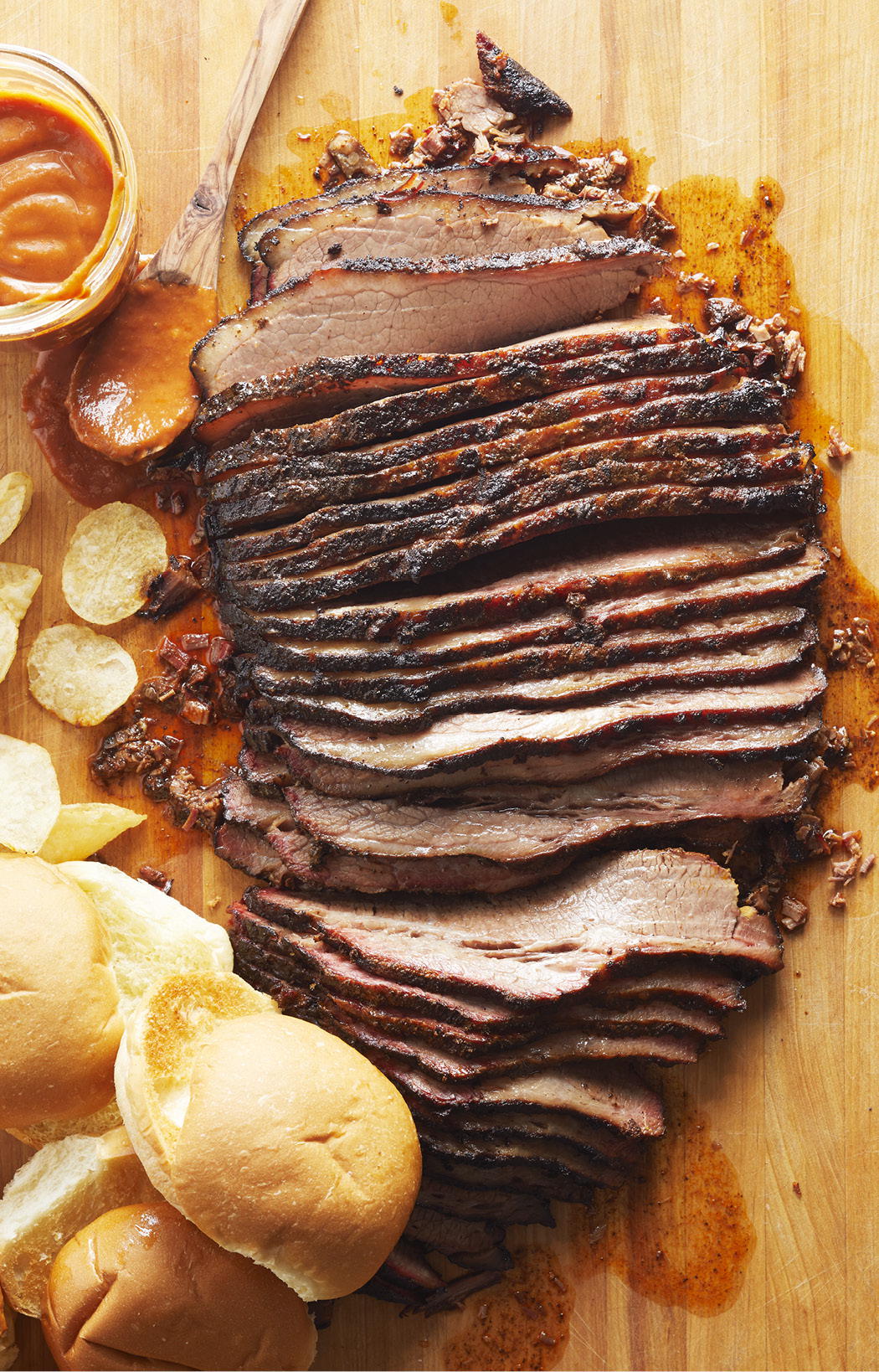
brisket barbecue sauce
hands-on time 10 minutes
cook 40 minutes
- 1 cup chopped onion
- 1 Tbsp. canola oil
- 1 14.5-oz. can whole tomatoes, undrained and cut up
- ⅔ cup white vinegar
- ¼ cup orange juice
- 2 Tbsp. Dijon mustard
- 1 Tbsp. granulated sugar
- 1 Tbsp. packed brown sugar
- 1 Tbsp. molasses
- 2 tsp. salt
- 1 tsp. liquid smoke
- ½ tsp. paprika
- ½ tsp. black pepper
- ¼ tsp. crushed red pepper
1. In a 3- to 4-qt. saucepan cook onion in hot oil over medium heat about 8 minutes or until golden brown, stirring frequently. Stir in the remaining ingredients. Bring to boiling; reduce heat. Simmer, uncovered, 30 to 40 minutes or until sauce is slightly thickened, stirring occasionally; cool slightly. Transfer sauce, half at a time, to a blender. Cover and blend until smooth.
Makes 2¼ cups (3 Tbsp. each).
each serving 42 cal., 1 g fat (0 g sat. fat), 0 mg chol., 486 mg sodium, 7 g carb., 1 g fiber, 5 g sugars, 0 g pro.
dry rub
In a bowl stir together ½ cup paprika; ⅓ cup black pepper; ¼ cup each salt, chili powder, ground cumin, and packed brown sugar; 3 Tbsp. granulated sugar; and 2 Tbsp. cayenne pepper. Store in an airtight container up to 1 month. Makes about 2 cups.
for a smoker
Rub brisket as directed. In a smoker arrange preheated coals, half of the wood chunks, and water pan according to manufacturer’s directions. Pour water into pan. Place brisket, fat side up, on a rack over water pan. Cover; smoke 4 to 5 hours or until brisket is tender. Add coals and water as needed to maintain temperature and moisture. Add wood chunks as needed during the first 3 hours. Continue as directed in Step 3.

make it a menu
ROASTED LEG OF LAMB
SAUTéED ZUCCHINI AND SUMMER SQUASH
WARM SOFT PITA BREAD
Roasted Leg of Lamb
hands-on time 30 minutes
roast 2 hours at 325°F
stand 15 minutes
- 1 5- to 6-lb. boneless whole leg of lamb, trimmed of fat
- Lemon juice
- 2 Tbsp. chopped fresh parsley
- 1 Tbsp. chopped fresh mint or basil or 1 tsp. dried mint or basil, crushed
- 1 Tbsp. chopped fresh rosemary or ½ tsp. dried rosemary, crushed
- ½ tsp. onion salt
- ¼ tsp. black pepper
- 1 to 2 cloves garlic, slivered
1. Preheat oven to 325°F. Cut ½-inch-wide slits about 1 inch deep into meat. Drizzle lemon juice over meat and into slits. In a bowl combine next five ingredients (through pepper). Sprinkle mixture over meat and into slits; rub in with your fingers. Insert garlic into slits.
2. Place meat on a rack in a shallow roasting pan. Roast 2 to 2½ hours for medium rare (135°F) or 2½ to 3 hours for medium (150°F). Remove from oven. Cover with foil; let stand 15 minutes.
Makes 12 servings (4 to 5 oz. lamb each).
each serving 311 cal., 21 g fat (9 g sat. fat), 100 mg chol., 151 mg sodium, 1 g carb., 0 g fiber, 0 g sugars, 27 g pro.
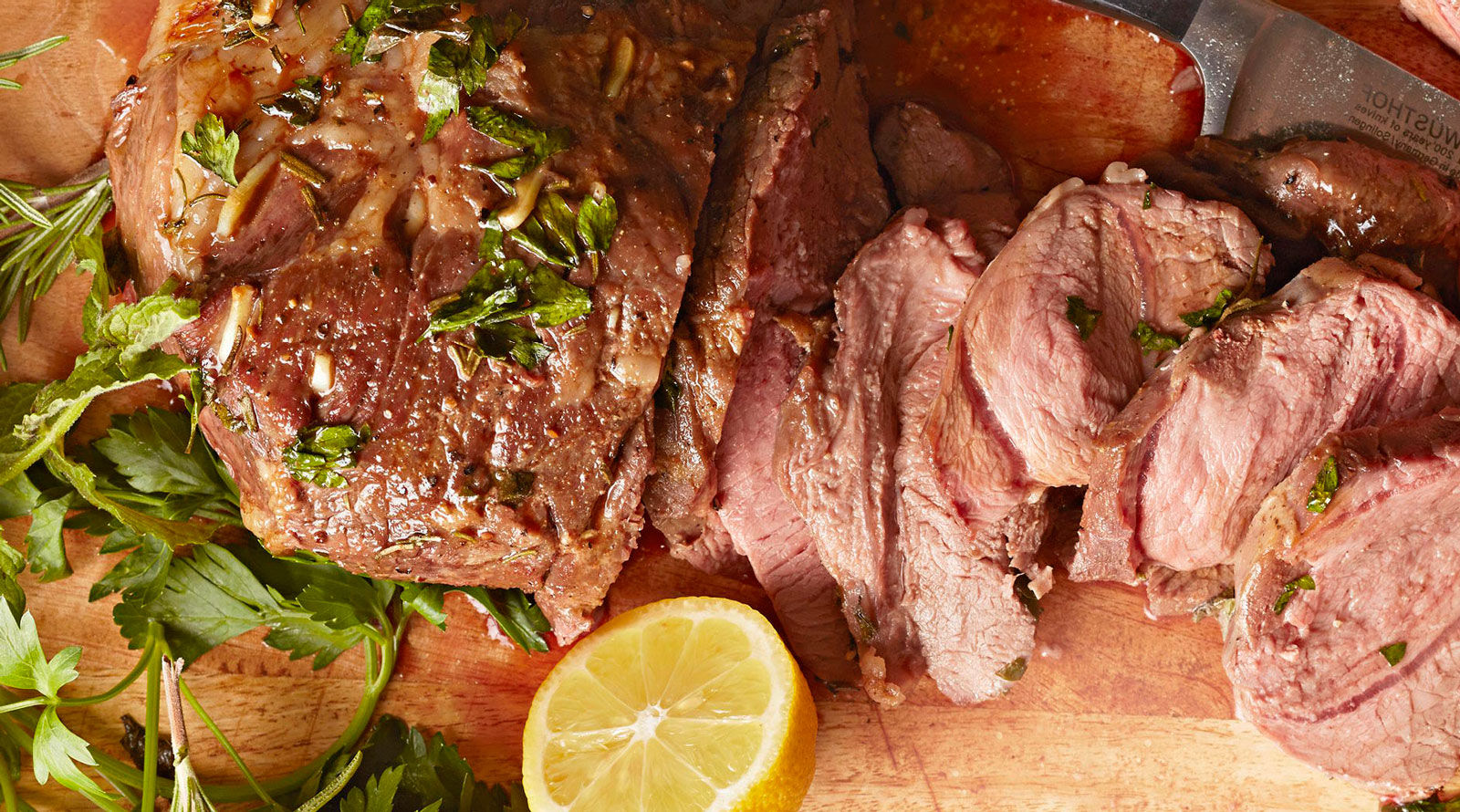
roasted leg of lamb
Lemon-Rosemary Roasted Pork Loin
hands-on time 25 minutes
roast 1 hour at 375°F
stand 10 minutes
- 1 lemon
- 6 to 8 cloves garlic, minced
- 2 Tbsp. olive oil
- 2 Tbsp. coarse-ground Dijon mustard
- 2 Tbsp. chopped fresh rosemary
- 1 tsp. salt
- ¼ tsp. black pepper
- 1 2- to 2½-lb. boneless pork top loin roast (single loin)
1. Preheat oven to 375°F. Remove 2 tsp. zest and squeeze 2 Tbsp. juice from lemon. In a bowl combine zest, juice, and the next six ingredients (through pepper). Spread pork roast with lemon-rosemary mixture and place roast on a rack in a shallow roasting pan.
2. Roast, uncovered, 1 to 1¼ hours or until a thermometer inserted in thickest part of the roast registers 145°F. Transfer roast to a platter. Cover loosely with foil. Let stand 10 minutes before carving.
Makes 8 servings (4 oz. pork each).
each serving 335 cal., 12 g fat (3 g sat. fat), 80 mg chol., 464 mg sodium, 28 g carb., 1 g fiber, 20 g sugars, 27 g pro.

lemon-rosemary roasted pork loin
Spanish Stuffed Pork Loin
hands-on time 50 minutes
roast 20 minutes at 450°F + 1 hour at 325°F
stand 15 minutes
- 15 oz. uncooked chorizo sausage
- ¾ cup chopped onion
- ½ cup roasted piquillo peppers or sweet peppers, chopped
- 2 cloves garlic, minced
- 1 tsp. fresh thyme leaves
- ½ cup Marcona almonds, coarsely chopped
- ¼ cup chopped pitted dates
- 1 4- to 5-lb. boneless pork top loin roast (single loin)
- ½ tsp. salt
- ½ tsp. black pepper
- ¼ tsp. smoked paprika
- 1 cup coarsely shredded Manchego cheese (4 oz.)
- 10 slices bacon
1. Preheat oven to 450°F. If sausage is in links, remove casings. In a 10-inch skillet cook sausage over medium heat 3 minutes. Add onion, roasted peppers, garlic, and thyme; cook and stir 10 minutes more. Drain fat. Stir in almonds and dates.
2. Trim fat from pork. Butterfly pork by making a lengthwise cut down the center of the meat, cutting to within ½ inch of the other side (tip, far right). Spread open. Place knife in the “V” of the cut. Cut horizontally into the meat and away from the center to within ½ inch of the other side of the meat. Repeat on opposite side of the “V.” Spread meat open. Cover meat with plastic wrap. Using the flat side of a meat mallet, work from center (thicker part) to edges to flatten to ½ to ¾ inch thick.
3. Sprinkle pork with salt, black pepper, and smoked paprika. Spread sausage mixture over one side of pork; sprinkle sausage mixture with cheese. Starting with the filled side, roll pork into a spiral.
4. On a sheet of waxed paper arrange bacon slices with long sides touching. Place pork crosswise in center of the bacon. Use the waxed paper to lift the bacon and wrap it around the pork. Tie at 2-inch intervals with 100%-cotton kitchen string. Place pork on a rack in a shallow roasting pan. Insert an oven-going meat thermometer into center of meat.
5. Roast, uncovered, 20 minutes. Reduce oven temperature to 325°F and roast 1 to 1¼ hours or until thermometer registers 155°F.
6. Transfer roast to a cutting board. Cover loosely with foil; let stand 15 minutes. (Temperature of meat after standing should be 160°F.) Cut pork into 1½-inch-thick slices.
Makes 10 servings (1 slice each).
each serving 750 cal., 53 g fat (19 g sat. fat), 187 mg chol., 1,202 mg sodium, 8 g carb., 1 g fiber, 4 g sugars, 57 g pro.

spanish stuffed pork loin
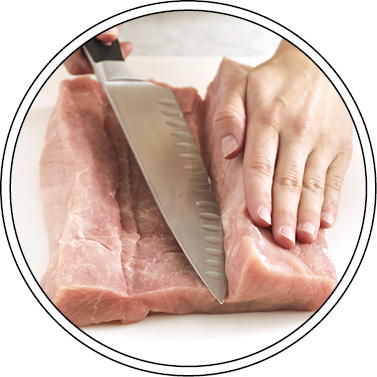
To butterfly a loin, make a lengthwise cut down the center of the roast, stopping ½ inch from the other side. Place the knife in the “V” you just made and lay it open on its side. Cut horizontally into the meat, away from center, to within ½ inch of other side. Repeat on the opposite side of the “V,” cutting the meat as evenly as possible. Spread the roast out, cover it with plastic wrap, and pound with a meat mallet to an even ½- to ¾-inch thickness.

make it a menu
HOLIDAY HAM
(To bake WITH HAM, BAKE 1¾ HOURS; UNCOVER. Bake 15 minutes more while carving ham.)
ORANGE- AND BALSAMIC-GLAZEDTRICOLOR CARROTS
(see recipe) OR STEAMED GREEN BEANS or ASPARAGUS

Here’s how to score your ham to get the flavor down deep. Using a sharp knife, cut the rind of the ham into a diamond pattern, making shallow diagonal cuts 1 inch apart and ¼ inch deep. Score top and sides.
Holiday Ham
hands-on time 15 minutes
bake 1 hour 30 minutes at 325°F
- 1 6- to 8-lb. bone-in cooked ham, rump half
- 1 recipe Cranberry-Orange Glaze or Mustard-Bourbon Glaze
1. Preheat oven to 325°F. Score ham (below left). Place ham on a rack in a shallow roasting pan. Insert an oven-going thermometer into center of ham (thermometer should not touch bone). Cover with foil.
2. Bake 1¼ hours. Uncover; bake 15 to 60 minutes more or until thermometer registers 140°F. Meanwhile, prepare desired glaze. Brush ham with some of the glaze the last 15 minutes of baking. Carve ham. Serve with remaining glaze.
Makes 20 servings (3 oz. ham + about 1 Tbsp. glaze each).
each serving 164 cal., 3 fat (1 g sat. fat), 74 mg chol., 891 mg sodium, 7 g carb., 0 g fiber, 1 g sugars, 27 g pro.

holiday ham with cranbery-Orange glaze
Cranberry-Orange Glaze
In a 1- or 1½-qt. saucepan combine 1 cup cranberry relish or orange-cranberry marmalade, ¼ cup orange juice, and 1 tsp. chopped fresh sage or thyme. Bring to boiling; reduce heat. Simmer, uncovered, 5 to 10 minutes or until mixture is thickened to glazing consistency.
mustard-bouRbon glaze
In a 1-qt. saucepan whisk together ⅓ cup each brown mustard and bourbon or orange juice; 2 Tbsp. each mild-flavor molasses and soy sauce; and 1 to 2 Tbsp. packed brown sugar. Cook and stir until mixture comes to boiling; reduce heat. Simmer, uncovered, about 10 minutes or until mixture is thickened to glazing consistency.
Pickle-Brined Chicken
hands-on time 25 minutes
marinate 8 hours
bake 15 minutes at 475°F
- 1 64-oz. jar dill pickles
- 6 bone-in chicken thighs, skinned if desired (2½ to 2¾ lb. total)
- ¼ cup all-purpose flour
- ½ tsp. black pepper
- 1 Tbsp. vegetable oil
- ¼ cup dry white wine or reduced-sodium chicken broth
- ¾ cup reduced-sodium chicken broth
- 1 Tbsp. butter
- 1 Tbsp. chopped fresh dill
- Coarsely chopped dill pickles
- Chopped red, yellow, and/or orange sweet pepper
1. Drain pickles, reserving brine (about 4 cups). (Place pickles in an airtight container. Store, covered, in the refrigerator up to 2 weeks.) Add chicken to brine in the pickle jar or place in a large resealable plastic bag set in a bowl; seal jar or bag. Chill 8 to 24 hours.
2. Preheat oven to 475°F. Remove chicken from brine; pat dry. Discard brine. In a shallow dish combine flour and pepper. Coat chicken with flour mixture; shake off any excess.
3. In a 10-inch oven-going skillet heat oil over medium-high heat. Add chicken, skin sides down. Cook about 8 minutes or until golden; turn chicken. Place skillet in oven. Bake about 15 minutes or until done (at least 175°F). Transfer chicken to platter; let rest 5 minutes.
4. Drain all but 1 Tbsp. drippings from skillet. Return skillet to heat. Add wine; bring to boiling over medium-high heat, stirring to scrape any browned bits from bottom of pan. Boil about 2 minutes or until wine nearly evaporates. Add broth; bring to boiling. Boil about 2 minutes or until reduced to about ½ cup. Stir in butter until melted. Season to taste with additional black pepper. Remove from heat; stir in dill. Pour sauce over chicken. Top with chopped pickles, sweet pepper, and additional dill.
Makes 6 servings (1 thigh + about 1 Tbsp. sauce each).
each serving 409 cal., 30 g fat (8 g sat. fat), 161 mg chol., 498 mg sodium, 5 g carb., 0 g fiber, 1 g sugars, 27 g pro.

pickle-brined chicken
why pickle juice?
The long marinating soak in pickle brine keeps the meat moist and infuses it with a savory salty-vinegary flavor. Use the drained pickles to make Pickle Poppers (p.398).

classic roast turkey
cooking class
roast turkey that’s golden brown on the outside, juicy on the inside—you can do it! get the tricks for glazing, stuffing, carving, gravy, and more.
Classic Roast Turkey
hands-on time 15 minutes
roast 2 hours 45 minutes at 325°F
stand 15 minutes
- 1 10- to 12-lb. turkey
- 1 recipe Orange and Herb Butter Rub and Glaze (optional)
- Salt and black pepper (optional)
- 1 recipe Stuffing (see recipe) or Turkey Aromatics (optional)
- Vegetable oil
- 1 recipe Perfect Turkey Gravy (see recipe)
1. Preheat oven to 325°F. Remove neck and giblets from turkey; reserve for another use or discard. Pat turkey skin dry with paper towels; if stuffing turkey, wipe out cavity. If desired, use Orange and Herb Butter Rub as directed and sprinkle body cavity with salt and pepper. If desired, spoon desired stuffing loosely into cavity. Skewer neck skin to back. Tuck drumstick ends under band of skin across the tail if present or tie drumsticks securely to the tail using 100%-cotton kitchen string. Twist wing tips under back.
2. Place turkey, breast side up, on a rack in a shallow roasting pan. Brush with oil; sprinkle with additional salt and pepper. Insert an oven-going meat thermometer into the center of an inside thigh muscle (thermometer should not touch bone). Cover turkey loosely with foil.
3. Roast turkey 2¼ hours. Remove foil; cut string between drumsticks. Roast 30 to 45 minutes more (1 to 1¼ hours if stuffed) or until thermometer registers at least 175°F; if stuffed, the center of stuffing must register 165°F. (Juices should run clear, and drumsticks should move easily in their sockets.) If desired, during the last 15 minutes of roasting, brush turkey twice with Orange and Herb Butter Glaze. Remove turkey from oven. Cover with foil; let stand 15 to 20 minutes before carving. Transfer turkey to a cutting board and carve (tip). If desired, garnish with fresh fruit and herbs. Serve with Perfect Turkey Gravy.
Makes 10 servings (7 oz. turkey each).
each serving 517 cal., 24 g fat (6 g sat. fat), 236 mg chol., 440 mg sodium, 3 g carb., 0 g fiber, 0 g sugars, 71 g pro.
RAW TURKEY and other cuts of poultry don’t need to be rinsed before cooking. See Roast Turkey Sheet-Pan Dinner for details.
orange and herb butter rub and glaze
start to finish 10 minutes
- ½ cup softened butter
- 2 tsp. chopped fresh sage
- 2 tsp. chopped fresh thyme
- 2 tsp. chopped fresh rosemary
- 1 tsp. orange zest
- ½ tsp. kosher salt
- ¼ tsp. black pepper
- ⅓ cup honey
1. In a medium bowl combine the first seven ingredients (through pepper).
2. For rub, after the turkey has been dried with paper towels, use your fingers to loosen the skin over breast meat. Lift skin; spread half of the butter mixture under the skin from front to back of turkey. Pull skin back over breast meat. Continue preparing turkey as directed in Step 1.
3. For glaze, microwave the remaining half of the butter mixture about 30 seconds or until melted. Stir in honey. Use to baste turkey the last 15 minutes of roasting.
Makes 10 servings (1 Tbsp. each).

Turkey Aromatics
If you aren’t stuffing the turkey, fill the cavity with aromatics. As they heat, these fruits, vegetables, and herbs release scented steam into the turkey cavity, flavoring the meat from within. Aromatics are not eaten, so no need to remove peels and stems. After sprinkling the cavity with salt and pepper, insert 1 medium orange, cut into wedges; 1 medium apple, cored and cut into wedges; 1 medium onion, cut into wedges; 1 small bulb garlic, top and bottom cut off to expose cloves; and 3 sprigs fresh sage, thyme, and/or rosemary into the cavity. Continue as directed in Step 1. Discard aromatics after roasting.
PREP & COOK

If you plan to stuff the turkey, first wipe out the cavity with paper towels. Spoon stuffing loosely into body cavity of the turkey. Do not pack the stuffing. Leaving it a little loose allows air circulation so the stuffing cooks evenly and reaches a safe temperature at the same time as the turkey. (Bake any extra stuffing in a dish.)

Use kitchen string to tie the legs together. If the tail is still on the turkey, secure legs to the tail. Wrap the string around the legs and tail, pull it tight, and tie a knot. Tuck the wing tips behind the back. Tucking the wings and tying the legs keep them tight against the body of the turkey, creating a uniform shape. This also helps the turkey roast at an even rate and prevents burning.

According to the U.S. Department of Agriculture, turkey meat is safe to eat at 165°F. In our Test Kitchen, we think turkeys look and taste better when the temperature reaches 175°F in the dark meat. Insert an oven-going thermometer into the thigh muscle, making sure the probe does not touch bone.

Dry turkey happens because lean white breast meat cooks faster than fattier dark meat thighs. By the time the thighs are done, breast meat may be overcooked. Tenting with foil deflects heat from the breast so it cooks more evenly with the thighs. To tent, form a large piece of foil loosely over the breast, allowing for some air circulation.

The Pan plan
A large roasting pan with a rack is ideal for turkeys because it is sturdy and has strong handles for easy lifting and shifting of the pan. If you don’t have one, use a 13×9-inch baking pan and place vegetables under the turkey to serve as a rack. Or purchase a large foil roasting pan at the supermarket and put a strong shallow baking pan under it for stability when transferring it in and out of the oven.
CARVING

Pull the legs away from the body of the turkey and cut the joints that attach the thighs to the body. On the cutting board cut the joints connecting the drumsticks and thighs. Slice meat from the thighs.
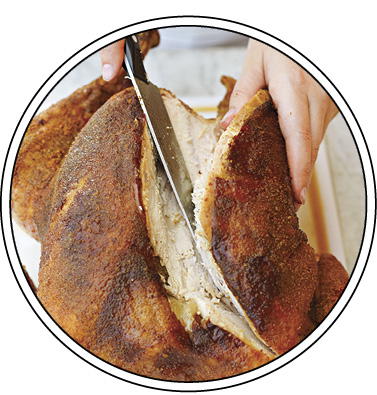
Holding a breast half with one hand or a meat fork, gently cut the meat from the bone, following as close to the rib cage as possible. On the cutting board cut the breast halves crosswise into slices.
turkey math As a general rule when buying turkey, plan on 1 lb. per person. If you like leftover turkey, make it 1½ lb. per person.
Perfect Turkey Gravy
start to finish 15 minutes
- Reduced-sodium chicken broth or turkey broth
- Pan drippings from Classic Roast Turkey (see recipe)
- Melted butter (optional)
- ¼ cup all-purpose flour
- Salt and black pepper
1. Stir 1 cup chicken broth into pan drippings from roasted turkey in roasting pan, scraping any browned bits from bottom of pan. Pour drippings into a 2-cup glass measuring cup. Skim and reserve fat from drippings. If necessary, add enough melted butter to the reserved fat to make ¼ cup. Add enough additional broth to the drippings in the measuring cup to make 2 cups total liquid.
2. Pour the ¼ cup fat into a 2-qt. saucepan (discard any remaining fat). Whisk in flour until smooth.
3. Add broth mixture all at once to saucepan, stirring until smooth. Cook and stir over medium heat until thickened and bubbly. Cook and stir 1 minute more. Season to taste with salt and pepper. Before serving, strain gravy into a serving bowl.
Makes 2 cups (¼ cup each).
each serving 76 cal., 6 g fat (2 g sat. fat), 7 mg chol., 211 mg sodium, 3 g carb., 0 g fiber, 0 g sugars, 1 g pro.

gravy for a crowd
If 2 cups of gravy isn’t enough, the recipe is easily doubled. Use drippings as directed in Step 1 and add enough broth to make 4 cups total liquid. If there isn’t ½ cup fat from the drippings, add enough melted butter to reach ½ cup. Stir ½ cup flour into fat in Step 2; continue as directed.
drippings-free gravy
If you’d rather skip the drippings, just use all broth and substitute butter for the fat. Boost the flavor by adding 1 to 2 tsp. chicken broth base.
MAKING GRAVY
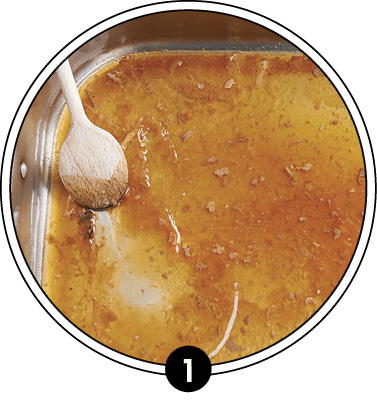
The drippings are loaded with flavor—as are the browned bits stuck to the bottom of the pan. You definitely want that flavor in your gravy. Scrape the bottom of the roasting pan to loosen bits after adding the broth.
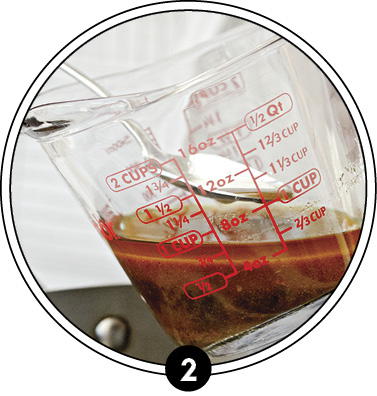
Pour broth mixture into a measuring cup. The fat will rise to the top; skim with a shallow spoon. For a smooth roux (and smooth gravy), you’ll need equal parts fat and flour. If the turkey didn’t yield enough fat, add melted butter.
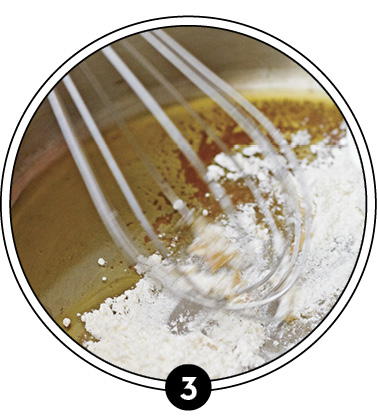
A whisk works best to combine fat and flour. You want all the starch particles in the flour to be coated with fat. Whisk the roux while adding broth. Heat until bubbly to cook away raw flour flavor and thicken the gravy.
Boiled Lobster
start to finish 30 minutes
- 8 qt. water
- ½ cup coarse kosher salt or salt
- 2 1- to 1½-lb. live lobsters
- 1 recipe Basic (Clarified Butter) or Beurre Blanc (below)
1. In a 20-qt. or larger kettle bring water and salt t8o boiling. Grasp lobsters just behind the head and rinse under cold running water. Quickly put lobsters headfirst into the boiling water. Cover and return to boiling. Boil 15 minutes, adjusting heat as necessary to maintain a steady boil. Drain lobsters; remove any bands on large claws.
2. When cool enough to handle, place each lobster on its back. Separate the lobster tail from the body (below left). Cut through tail membrane to expose meat. Remove and discard the black vein running through the tail. Remove meat from tail. Twist the large claws away from the body. Using a nutcracker, break open the claws. Remove meat from claws. Crack the shell on remaining part of the body; remove meat with a small fork. Discard the green tomalley (liver) and the coral roe (found in female lobsters). Serve lobster meat with Basic Clarified Butter.
Makes 2 servings (1 lobster + 2 Tbsp. butter each).
each serving 344 cal., 24 g fat (15 g sat. fat), 209 mg chol., 1,894 mg sodium, 1 g carb., 0 g fiber, 0 g sugars, 30 g pro.

boiled lobster with lemon-chive clarified butter and beurre blanc
fresh lobsters
When buying live lobsters, pick ones that appear active and cook them the day you buy them. Refrigerate lobsters in a shallow pan covered with a damp towel until ready to cook.

Remove tail by twisting the tail and body in opposite directions. Cut the membrane from the tail to expose the meat.

Twist the large claws where they join the body to remove them.

Break the large claws open with a nutcracker.
change it up
Use any leftover lobster meat to make lobster rolls. Stir lobster meat together with a little mayonnaise, lemon juice, salt, and black pepper. Spoon the lobster salad into a toasted hoagie roll and sprinkle with chives.
Beurre Blanc
start to finish 20 minutes
- ¼ cup dry white wine
- 2 Tbsp. finely chopped shallot
- 1 Tbsp. white wine vinegar
- 2 Tbsp. heavy cream
- ¾ cup cold unsalted butter (1½ sticks), cut into 2-Tbsp. pieces
- Salt and white pepper
1. In a 1- or 1½-qt. nonreactive saucepan (stainless-steel, enamel, or nonstick) combine the wine, shallot, and vinegar. Bring to boiling; reduce heat to medium. Boil gently, uncovered, 7 to 9 minutes or until almost all of the liquid has evaporated. Stir in the cream. Bring to boiling; boil about 1 minute to reduce the cream slightly. Reduce heat to medium-low.
2. Using a wire whisk, stir in the butter, one piece at a time, allowing each piece to melt before adding the next. Allow about 8 minutes. If desired, strain sauce. Season to taste with salt and white pepper. Serve with seafood or vegetables.
Makes 1 cup (2 Tbsp. each).
Lemony Beurre Blanc Prepare as directed, except substitute lemon juice for the vinegar. If desired, garnish with lemon zest.
Creamy Mustard Sauce Prepare as directed, except whisk in 2 tsp. Dijon mustard before serving.
each serving plain, lemony, or creamy mustard variation 174 cal., 19 g fat (12 g sat. fat), 51 mg chol., 41 mg sodium, 1 g carb., 0 g fiber, 0 g sugars, 0 g pro.
Steamed Crab Legs
start to finish 15 minutes
- 4 4- to 8-oz. fresh or frozen crab legs
- 1 lemon
- ¼ cup butter, melted
- 1 Tbsp. chopped fresh basil or fresh Italian parsley
1. Thaw crab legs if frozen. Place crab legs in a steamer basket in a 12-inch skillet. If necessary, bend crab legs at joints to fit in steamer basket. Add water to skillet to just below the basket. Bring to boiling. Cover; steam 5 to 6 minutes or until heated through.
2. For butter sauce, remove ½ tsp. zest and squeeze 1 Tbsp. juice from lemon. Stir together butter, basil, lemon zest, and lemon juice.
3. To remove crabmeat, twist legs at joints or split shells using kitchen scissors. Peel back shells; remove meat. Serve with butter sauce.
Makes 4 servings (4 oz. crab each).
Boiled Crab Legs Thaw crab legs if frozen. Place crab legs in a large pot of boiling salted water. Return to boiling. Cook, uncovered, 4 to 5 minutes or until heated through.
each serving 157 cal., 12 g fat (7 g sat. fat), 58 mg chol., 622 mg sodium, 0 g carb., 0 g fiber, 0 g sugars, 12 g pro.
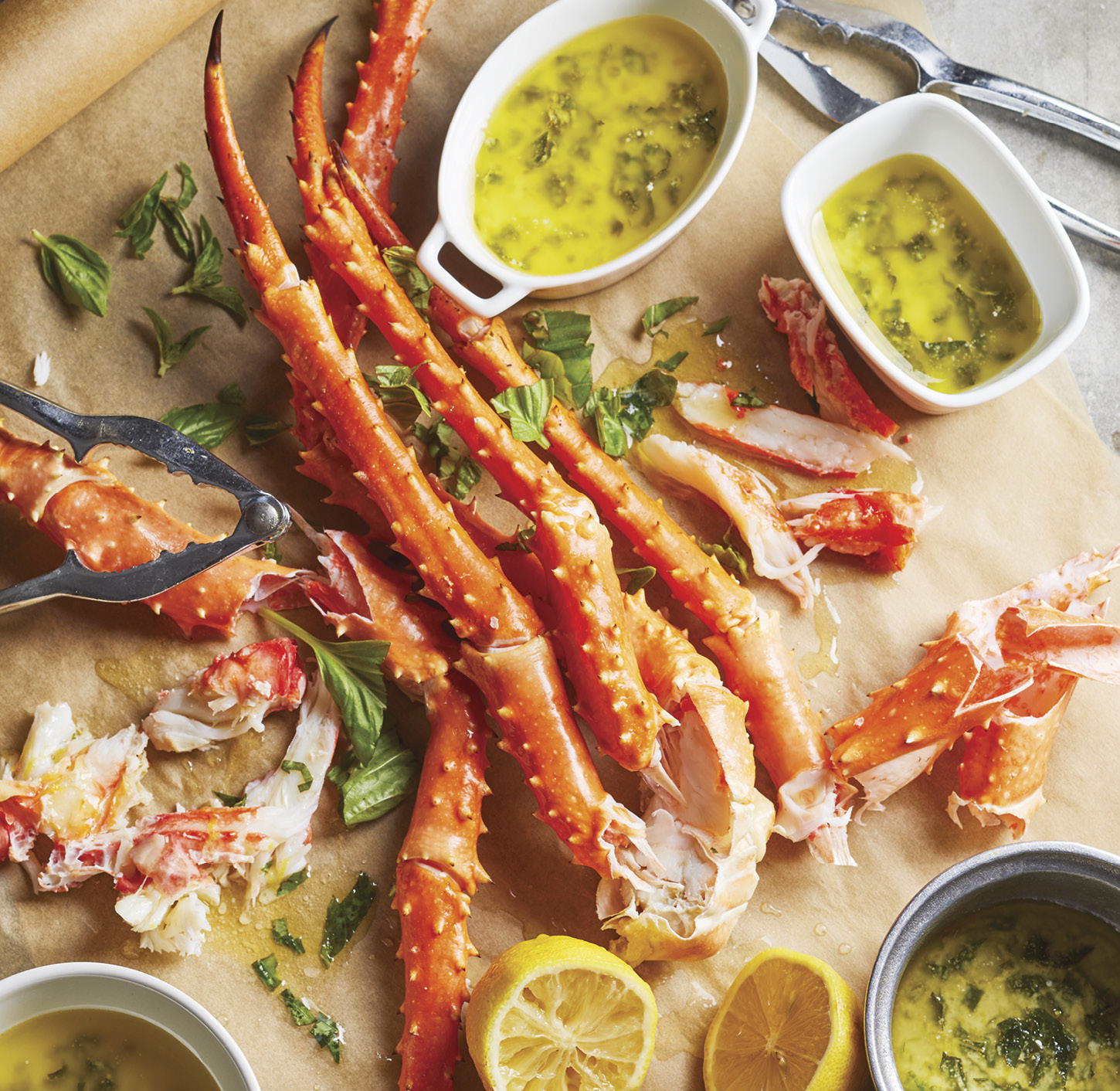
steamed crab legs

make it a menu
steamed crab legs
broccolini with peas and lemons (see recipe) or a green salad with Fresh herb vinaigrette (see recipe)
roasted fingerling potatoes sprinkled with coarse salt
crusty italian bread

shrimp and sausage boil
finger food
Known as Low Country shrimp boil in the southeastern United States, this summery one-pot meal is traditionally served on a table lined with newspapers.
Shrimp and Sausage Boil
hands-on time 1 hour
cook 25 minutes
- 1 3-oz. bag shrimp and crab boil
- 3 Tbsp. seafood seasoning, such as Old Bay
- 2¼ to 3 lb. small new potatoes
- 4 to 5 ears corn, husked and cut in 1½- to 3-inch pieces
- 1 to 2 lb. spicy smoked link sausage (kielbasa or andouille), diagonally sliced into 1-inch pieces
- 3 to 4 lb. medium to large unpeeled shrimp (preferably heads on)
- 3 to 4 lemons, halved
- Snipped fresh Italian parsley
1. In a 12- to 16-qt. pot bring 2 gallons water to boiling. Add shrimp and crab boil and seafood seasoning; reduce heat. Simmer, uncovered, 10 minutes. Add potatoes, a few at a time, allowing water to continue simmering. Simmer 7 to 10 minutes until nearly tender. Add corn; simmer, uncovered, 5 minutes. Add sausage and shrimp. Simmer 3 to 5 minutes or until shrimp are opaque (do not overcook shrimp) and sausage is heated through; drain.
2. Transfer to large platter. Add lemon halves and sprinkle parsley over top. Serve hot or within 1 hour of cooking.
Makes 6 servings.
each serving 678 cal., 34 g fat (11 g sat. fat), 339 mg chol., 1,356 mg sodium, 41 g carb., 5 g fiber, 5 g sugars, 53 g pro.
broiled Lobster Tails
start to finish 30 minutes
- 4 8-oz. fresh or frozen lobster tails
- ¼ cup butter
- 1 tsp. orange zest
- ½ tsp. chili powder
- 1 clove garlic, minced
- Snipped fresh parsley (optional)
- 2 recipes Basic Clarified Butter (optional)
1. Thaw lobster tails if frozen. Preheat broiler. Butterfly the lobster tails by using kitchen scissors to cut lengthwise through centers of hard top shells and meat, cutting to but not through bottoms of shells. Spread the halves of tails apart. Place tails, meat sides up, on unheated rack of a broiler pan.
2. In saucepan melt butter. Add orange zest, chili powder, and garlic; heat about 30 seconds or until garlic is tender. Brush mixture over lobster meat. Broil 4 inches from heat 12 to 14 minutes or until lobster meat is opaque. If desired, sprinkle with parsley and serve with Basic Clarified Butter.
Makes 4 servings (1 tail each).
each serving 149 cal., 12 g fat (7 g sat. fat), 78 mg chol., 211 mg sodium, 1 g carb., 0 g fiber, 0 g sugars, 10 g pro.

broiled lobster tails
clarified butter
Clarified butter, also called ghee, is butter that has been melted and the milk solids removed. The remaining butter fat is clear when melted, making it attractive for serving with lobster and crab. Because the milk solids are removed, it can also be used for sautéeing at higher temperatures than whole butter.
basic clarified butter Melt ¼ cup butter over very low heat without stirring; cool slightly. Strain through a sieve lined with 100%-cotton cheesecloth into a glass measure. Pour off clear top layer; discard milky bottom layer. Chill and remelt to serve.
lemon-chive clarified butter Prepare Basic Clarified Butter as directed. Stir in 2 Tbsp. chopped fresh chives and 1 tsp. lemon zest.
basil clarified butter Prepare Basic Clarified Butter as directed. Stir in 2 Tbsp. chopped fresh basil.
Chicken, Shrimp, and Chorizo Paella
hands-on time 50 minutes
stand 10 minutes
- ½ tsp. saffron threads, crushed
- 2 Tbsp. olive oil
- 1 lb. skinless, boneless chicken thighs, cut into 2-inch pieces
- 4 oz. smoked Spanish-style chorizo sausage, sliced
- 1 cup chopped onion
- 4 cloves garlic, minced
- 1 cup coarsely grated tomatoes (about 1 lb.)
- 1 Tbsp. smoked sweet paprika
- 6 cups reduced-sodium chicken broth
- 2 cups short grain rice
- 12 large shrimp, peeled and deveined
- 8 oz. frozen peas, thawed
- Chopped green olives (optional)
- Chopped Italian parsley
1. In a bowl combine saffron and ¼ cup hot water; let stand 10 minutes.
2. Meanwhile, in a 15-inch paella pan heat oil over medium-high heat. Add chicken; cook about 5 minutes or until chicken is browned, turning occasionally. Add chorizo; cook 1 minute more. Transfer chicken and chorizo to a plate. Add onion and garlic to pan; cook and stir 2 minutes. Add tomatoes and paprika; cook and stir 5 minutes more or until tomatoes are thickened and almost pastelike.
3. Return chicken and chorizo to pan. Add chicken broth, saffron mixture, and ½ tsp. salt; bring to boiling over high heat. Add rice to pan, stirring once to evenly distribute. Cook, without stirring, until rice has absorbed most of the liquid, about 12 minutes. (If your pan is bigger than your burner, rotate every few minutes to ensure the rice cooks evenly.) Reduce heat to low. Cook, without stirring, 5 to 10 minutes more until all the liquid is absorbed and rice is al dente. Top with shrimp and peas. Turn heat to high. Cook, without stirring, 1 to 2 minutes more (edges should look dry and a crust should form on the bottom). Remove from heat. Cover pan with foil. Let stand 10 minutes before serving. Sprinkle with olives (if desired) and parsley.
Makes 6 servings (1⅓ cups each).
each serving 577 cal., 17 g fat (4 g sat. fat), 322 mg chol., 927 mg sodium, 63 g carb., 5 g fiber, 5 g sugars, 41 g pro.

chicken, shrimp, and chorizo paella

SAFFRON
Bright yellow saffron—the hand-harvested stigma of a special crocus flower—is paella’s secret ingredient, giving it that trademark golden hue and deep flavor. It’s pricey, but you need just a pinch. Steeping the threads in water releases all that color and flavor.
GRATING TOMATOES makes it easier to remove the skins (and makes them blend into the mixture better). Core and cut tomatoes in half. Grate on the coarse holes of a box grater into a shallow dish. Discard skins.
PAELLA PANS are wide and shallow so rice cooks in a thin layer. If you don’t have one, use a 12-inch skillet. Prepare as directed, except reduce rice to 1½ cups and reduce chicken broth to 4 cups.
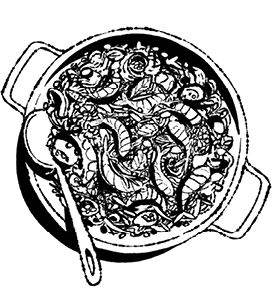
Mile-High Lasagna Pie
hands-on time 50 minutes
bake 1 hour at 375°F
stand 15 minutes
- 16 dried whole wheat or whole grain lasagna noodles
- 2 Tbsp. olive oil
- 2 cups finely chopped zucchini
- 1½ cups finely chopped carrots
- 4 cloves garlic, minced
- 3 cups sliced fresh mushrooms
- 2 6-oz. pkg. fresh baby spinach
- 2 Tbsp. chopped fresh basil
- 1 egg, beaten
- 1 15-oz. container ricotta cheese
- ⅓ cup finely shredded Parmesan cheese
- ½ tsp. salt
- ¼ tsp. black pepper
- 1 26-oz. jar tomato and basil pasta sauce (2½ cups)
- 2 cups shredded Fontina or mozzarella cheese (8 oz.)
- Quartered cherry tomatoes (optional)
1. Preheat oven to 375°F. In a 4- to 5-qt. pot cook noodles according to package directions. Drain noodles; rinse with cold water. Drain well.
2. Meanwhile, in a 10-inch skillet heat 1 Tbsp. of the olive oil over medium-high heat. Add zucchini, carrots, and half of the garlic. Cook and stir about 5 minutes or until crisp-tender. Transfer vegetables to a bowl. Add the remaining oil to the same skillet and heat over medium-high heat. Add mushrooms and remaining garlic. Cook and stir about 5 minutes or until tender. Gradually add spinach. Cook and stir 1 to 2 minutes or until spinach is wilted. Remove from skillet with a slotted spoon; stir in basil.
3. In a bowl stir together the next five ingredients (through pepper).
4. To assemble, in the bottom of a 9×3-inch springform pan spread ½ cup of the pasta sauce. Arrange three to four of the cooked noodles over the sauce, trimming and overlapping as necessary to cover sauce with one layer. Top with half of the mushroom mixture. Spoon half of the ricotta cheese mixture over mushroom mixture. Top with another layer of noodles. Spread with 1 cup of the remaining sauce. Top with all of the carrot mixture. Sprinkle with half the Fontina cheese. Top with another layer of noodles. Layer with remaining mushroom mixture and remaining ricotta cheese mixture. Top with another layer of noodles (you might have extra noodles) and remaining sauce. Gently press down pie with the back of a spatula.
5. Place springform pan on a foil-lined baking sheet. Bake about 60 minutes or until heated through, topping with remaining Fontina cheese the last 15 minutes. Cover and let stand 15 minutes before serving. Loosen outside edges of pie and carefully remove pan ring. To serve, cut lasagna into wedges. If desired, garnish with cherry tomatoes and additional fresh basil.
Makes 10 servings (1 wedge each).
each serving 463 cal., 23 g fat (12 g sat. fat), 82 mg chol., 965 mg sodium, 38 g carb., 8 g fiber, 10 g sugars, 28 g pro.
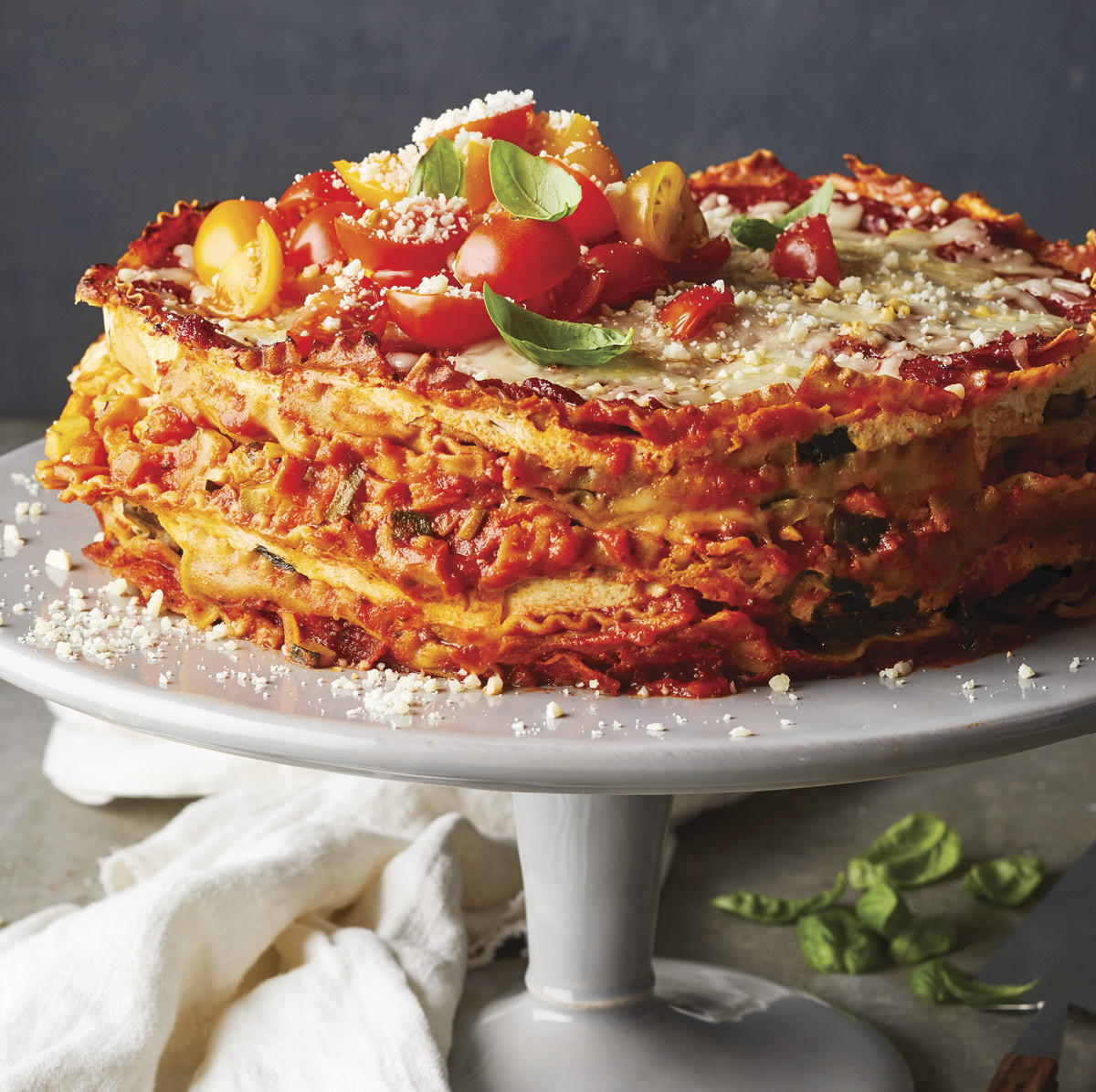
mile-high lasagna pie
easy EVERYDAY
For oven-to-table dining, make this lasagna in a 13×9-inch pan instead. Use 4 noodles per layer and bake about 45 minutes or until heated.